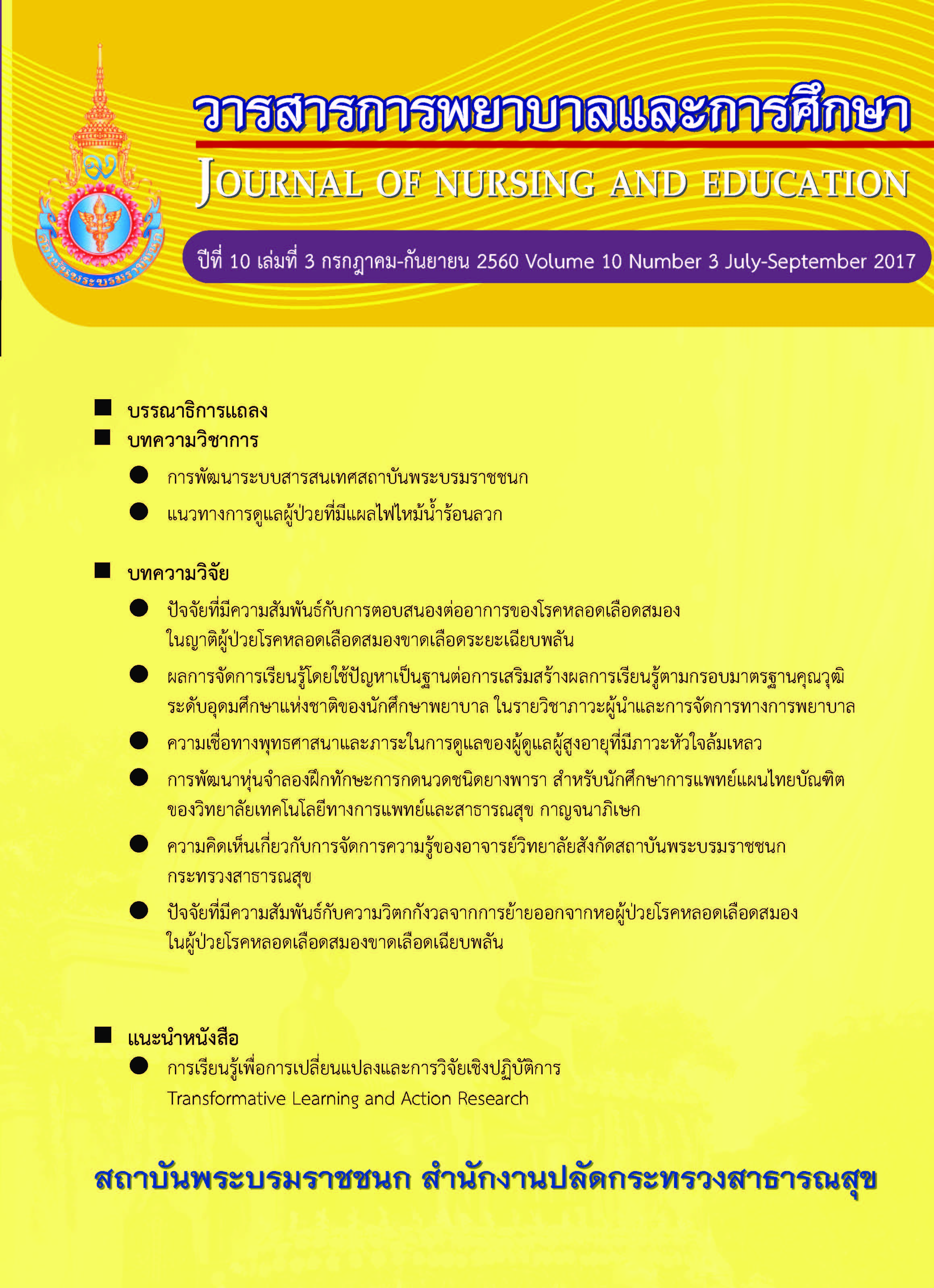ปัจจัยที่มีความสัมพันธ์กับความวิตกกังวลจากการย้ายออกจากหอผู้ป่วยโรคหลอดเลือดสมองในผู้ป่วยโรคหลอดเลือดสมองขาดเลือดเฉียบพลัน
Factors Related to Anxiety among Acute Ischemic Stroke Patients Transferring out of Stroke Unit
คำสำคัญ:
เครื่องมือดิจิทัล การเรียนรู้ การศึกษายุคดิจิทัลบทคัดย่อ
บทคัดย่อ
วัตถุประสงค์ของการวิจัยครั้งนี้ เพื่อศึกษาความวิตกกังวลจากการย้ายออก และปัจจัยที่มีความสัมพันธ์กับความวิตกกังวลในผู้ป่วยโรคหลอดเลือดสมองขาดเลือดเฉียบพลันที่ย้ายออกจากหอผู้ป่วยโรคหลอดเลือดสมอง กลุ่มตัวอย่างจำนวน 82 ราย คัดเลือกโดยวิธีการสุ่มอย่างง่ายจากผู้ป่วยที่ย้ายออกจากหอผู้ป่วยโรคหลอดเลือดสมอง เครื่องมือที่ใช้ในการเก็บรวบรวมข้อมูลได้แก่ แบบสัมภาษณ์ข้อมูลทั่วไป แบบบันทึกประวัติการเจ็บป่วยและการรักษา แบบสัมภาษณ์ความวิตกกังวลจากการย้ายออกจากหอผู้ป่วยโรคหลอดเลือดสมอง แบบสัมภาษณ์การรับรู้ความรุนแรงของโรค และแบบสัมภาษณ์การสนับสนุนด้านข้อมูลและอารมณ์ มีค่าความเชื่อมั่นเท่ากับ 0.86, 0.93 และ 0.80 ตามลำดับ วิเคราะห์ข้อมูลด้วยสถิติพรรณนา และค่าสัมประสิทธ์สหสัมพันธ์ของสเปียร์แมน
ผลการวิจัยพบว่า ความวิตกกังวลของกลุ่มตัวอย่างจากการย้ายออกจากหอผู้ป่วยโรคหลอดเลือดสมองอยู่ในระดับปานกลาง (M = 76.59, SD = 8.27) การรับรู้ความรุนแรงของการเจ็บป่วยมีความสัมพันธ์ทางบวกในระดับปานกลางกับความวิตกกังวลจากการย้ายอออกจากหอผู้ป่วยโรคหลอดเลือดสมองอย่างมีนัยสำคัญทางสถิติ (rs = 0.343, p < .01) แต่ไม่พบความสัมพันธ์ระหว่างระยะเวลาการนอนในหอผู้ป่วยหนัก การสนับสนุนด้านข้อมูลและอารมณ์กับความวิตกกังวลจากการย้ายออกจากหอผู้ป่วยโรคหลอดเลือดสมอง (p > .05)
ผลการวิจัยนี้แสดงให้เห็นว่า การลดการรับรู้ความรุนแรงของการเจ็บป่วยก่อนการย้ายออกจากหอผู้ป่วยโรคหลอดเลือดสมองเป็นสิ่งสำคัญ พยาบาลควรให้ความรู้เกี่ยวกับโรคที่ถูกต้องและเพียงพอ รวมทั้งการวางแผนการย้ายออกอย่างเหมาะสมจะช่วยลดความวิตกกังวลของผู้ป่วยโรคหลอดเลือดสมองจากการย้ายออกจากหอผู้ป่วยโรคหลอดเลือดสมองได้
ABSTRACT
This descriptive correlational study aimed to determine anxiety from transferring out and factors related to anxiety among acute ischemic stroke patients transferring out from a stroke unit. A simple random sampling was used to recruit a samples of 82 patients who were transferred out from a stroke unit. Research instruments consisted of a demographic questionnaire, a record form of illness history and treatment, the questionnaires of anxiety of transferring out of a stroke unit, perceived severity of illness, and the information and emotional supports. Their reliabilities were 0.86, 0.93 and 0.80, respectively. Data were analyzed by using descriptive statistics and Spearman’s rank correlation coefficients.
The results showed that anxiety of the sample for transferring out from a stroke unit was at a moderate level (M = 76.59, SD = 8.27). Perceived severity of illness was positively moderately related to anxiety of transferring out from a stroke unit (rs = 0.343, p < .01). However, length of stay and information and emotional supports were not related to anxiety of transferring out from a stroke unit (p > .05).
These findings indicate that reducing perceived severity of illness before transferring out from a stroke unit is important. Nurses should provide correct and adequate knowledge of the disease. In addition, appropriated discharge planning before transferring out could reduce anxiety among acute ischemic stroke patients transferring out from a stroke unit.
เอกสารอ้างอิง
1. Thammasaroch.P. Certified Primary Stroke Center; CPSC). Journal Thai Stroke Society, 2015; 14: 75-85. (in Thai).
2. Brooke, J. The exploration of self-regulation and transfer anxiety within stroke patients transferred from a hyper acute stroke unit to a ward, 2013; Doctoral dissertation, Health Psychology, Metropolitan University.
3. Leith, B. A. Transfer anxiety in critical care patients and their family members. Critical Care Nursing, 1998; 18: 24-32.
4. Zakerimoghadam,M., Ghyasvandian, S., Asayesh, H., & Jodaki, K. Prevalence of anxiety in the process of transferring patients from cardiac surgery intensive care unit to the general ward. Critical Care Nursing, 2016; 9(3): 8001- 8004.
5. Carpenito, L. J. Nursing diagnosis application to clinical practice (14thed.). [On line]. 2013. [2017/3/1]. Available from: http://nm.mui.ac.ir/sites/nm.mui.ac.ir/files/pdf/nursing%20diagnosis%20lynda%20carpenito%202013.pdf.
6. Wang, T. J., & Vadan, R. S. Contemporary reviews in cardiovascular medicine: Epidemiology of uncontrolled hypertension in the United States. Circulation, 2005; 112: 1651-1662.
7. Brodsky-Israeli, M., & DeKeyser-Ganz, F. Risk factors associated with transfer anxiety among patients transferring from the intensive care unit to the ward. Journal of Advanced Nursing, 2010; 67(3): 510-518.
8. Noommeechai. N. Selected Factors Related to Transfer Anxiety in From Intensive Care Unit. MNS. Thesis . Chulalongkorn University. Bangkok. 2007. (in Thai).
9. Thanuchan. R. Selected Factors Related to Transfer Anxiety in Critically Ill Patients. The Journal of Boromarajonani College of Nursing, Nakhonratchasima, 2015; 21(1): 18-30. (in Thai).
10. Faul, F., Erdfelder, E., Lang, A.-G., & Buchner, A. G*Power 3: A flexible statistical power analysis program for the social, behavioral, and biomedical sciences. Behavior Research Methods, 2007; 39(2): 175-191.
11. Boonmee, N. Effected of Clinical Nursing Practice Guideline for Discharge from Intensive Care Unit with Transfer Anxiety and Readmission in Intensive Care Unit, MNS. Thesis . Burapha University.
12. Pinthaisong. T. Factors Related to Oneset Arrival Time in Patients with Acute Stroke. Kuakarun Journal of Nursing, 2013; 20(1): 15-29. (in Thai).
13. Pochaiyo. S. Factors affecting coping behaviors in hemiplegic eldering at eastern region hospital in Thailand, MNS. Thesis .Burapha University. Chonburi. 2000. (in Thai).
14. Thammasaroch. P. Photology, Symptom and Diagnosis of Ischemic. Ischemic Stroke. Bangkok: Jaransanitwong; 2012. p. 22-79. (in Thai).
15. Pathomjaruvat. T. Correlation between awareness of self-performance, of disorder severity and of anxiety, and duration of spontaneous breathing trial in patients not having been weaned off respirators. 2013, Thai Journal of Nursing Council; 28(1): 49-63.
16. Sirisom. S. Factors related and predicted coping of older persons with stroke. 2013, North-Eastern Thai Journal of Neuroscience; 8(2): 70-81. (in Thai)






